Organizational Behaviour Report: City College and Enterprise Analysis
VerifiedAdded on 2020/01/23
|13
|4115
|121
Report
AI Summary
This report provides a comprehensive analysis of organizational behavior, focusing on the interplay between structure, culture, and leadership. It compares and contrasts different organizational structures and cultures, evaluating their impact on performance, specifically referencing City College and Enterprise. The report identifies factors influencing individual behavior in the workplace, explores the effectiveness of various leadership styles (autocratic and democratic), and examines their impact on employee motivation. It further delves into the application of motivation theories, such as Herzberg's Two-Factor Theory, and their effects on the workforce. The report also assesses the dynamics of group behavior, factors influencing team effectiveness, and the impact of technology on team performance, providing valuable insights into effective management and leadership strategies. The report concludes by summarizing the key findings and their implications for organizational success.
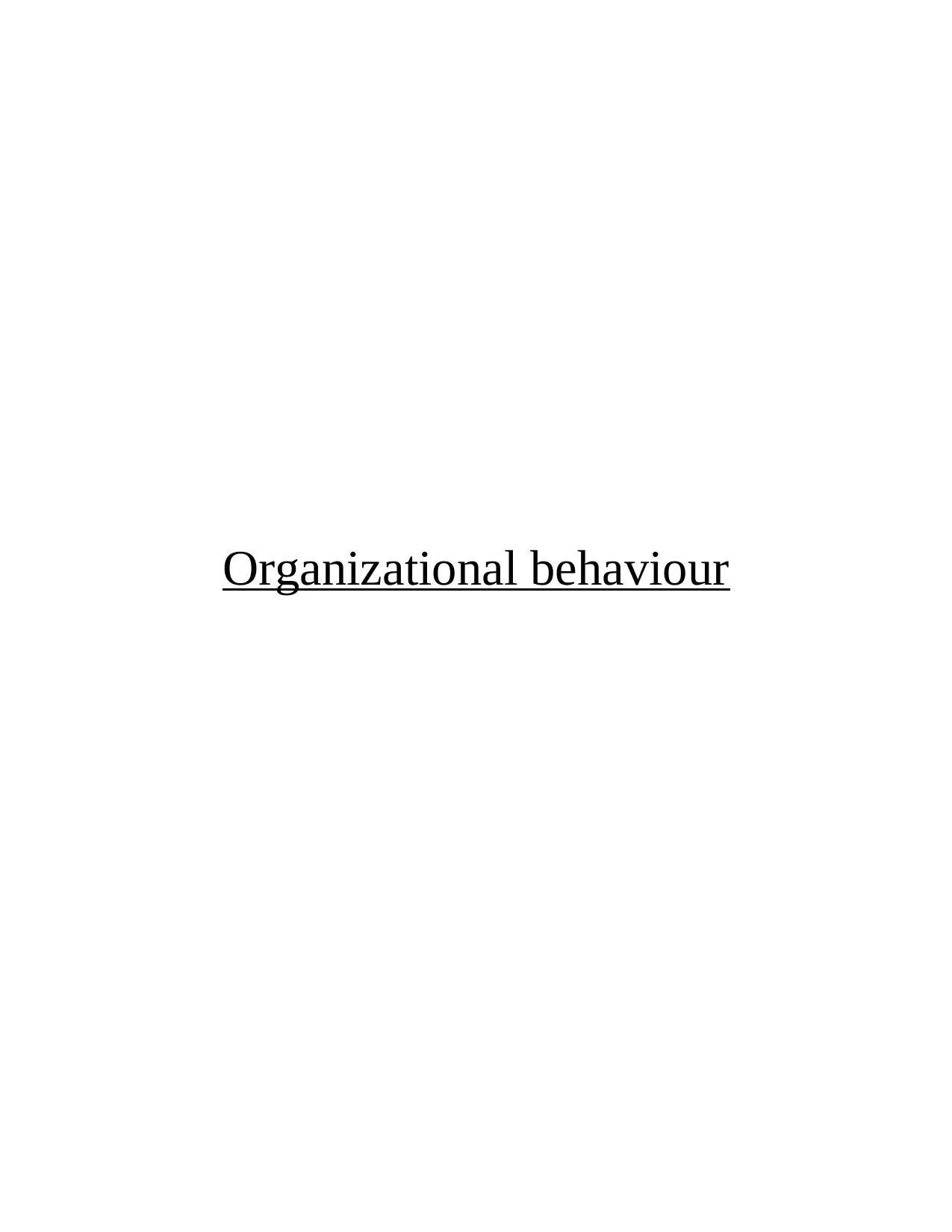
Organizational behaviour
Paraphrase This Document
Need a fresh take? Get an instant paraphrase of this document with our AI Paraphraser
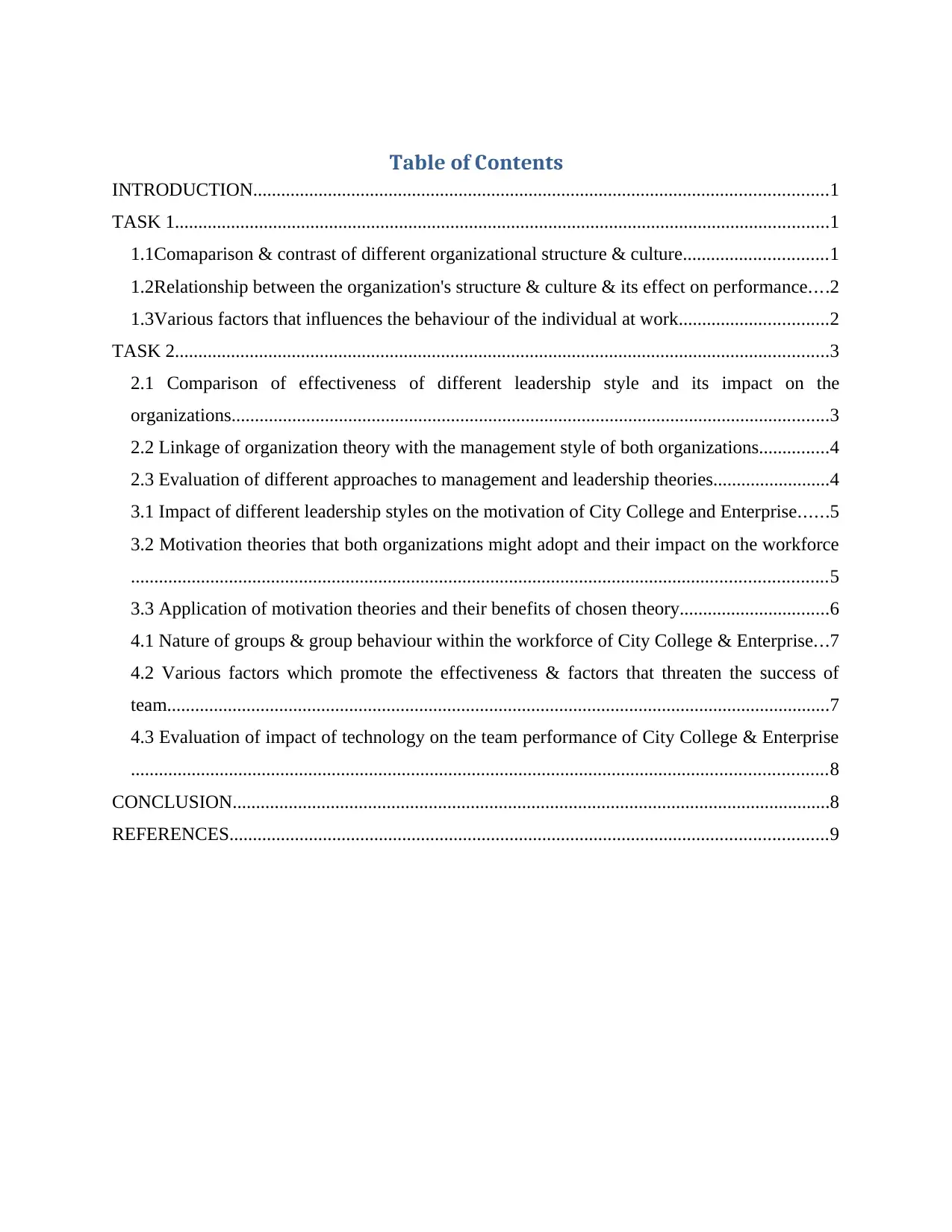
Table of Contents
INTRODUCTION...........................................................................................................................1
TASK 1............................................................................................................................................1
1.1Comaparison & contrast of different organizational structure & culture...............................1
1.2Relationship between the organization's structure & culture & its effect on performance....2
1.3Various factors that influences the behaviour of the individual at work................................2
TASK 2............................................................................................................................................3
2.1 Comparison of effectiveness of different leadership style and its impact on the
organizations................................................................................................................................3
2.2 Linkage of organization theory with the management style of both organizations...............4
2.3 Evaluation of different approaches to management and leadership theories.........................4
3.1 Impact of different leadership styles on the motivation of City College and Enterprise......5
3.2 Motivation theories that both organizations might adopt and their impact on the workforce
.....................................................................................................................................................5
3.3 Application of motivation theories and their benefits of chosen theory................................6
4.1 Nature of groups & group behaviour within the workforce of City College & Enterprise...7
4.2 Various factors which promote the effectiveness & factors that threaten the success of
team..............................................................................................................................................7
4.3 Evaluation of impact of technology on the team performance of City College & Enterprise
.....................................................................................................................................................8
CONCLUSION................................................................................................................................8
REFERENCES................................................................................................................................9
INTRODUCTION...........................................................................................................................1
TASK 1............................................................................................................................................1
1.1Comaparison & contrast of different organizational structure & culture...............................1
1.2Relationship between the organization's structure & culture & its effect on performance....2
1.3Various factors that influences the behaviour of the individual at work................................2
TASK 2............................................................................................................................................3
2.1 Comparison of effectiveness of different leadership style and its impact on the
organizations................................................................................................................................3
2.2 Linkage of organization theory with the management style of both organizations...............4
2.3 Evaluation of different approaches to management and leadership theories.........................4
3.1 Impact of different leadership styles on the motivation of City College and Enterprise......5
3.2 Motivation theories that both organizations might adopt and their impact on the workforce
.....................................................................................................................................................5
3.3 Application of motivation theories and their benefits of chosen theory................................6
4.1 Nature of groups & group behaviour within the workforce of City College & Enterprise...7
4.2 Various factors which promote the effectiveness & factors that threaten the success of
team..............................................................................................................................................7
4.3 Evaluation of impact of technology on the team performance of City College & Enterprise
.....................................................................................................................................................8
CONCLUSION................................................................................................................................8
REFERENCES................................................................................................................................9
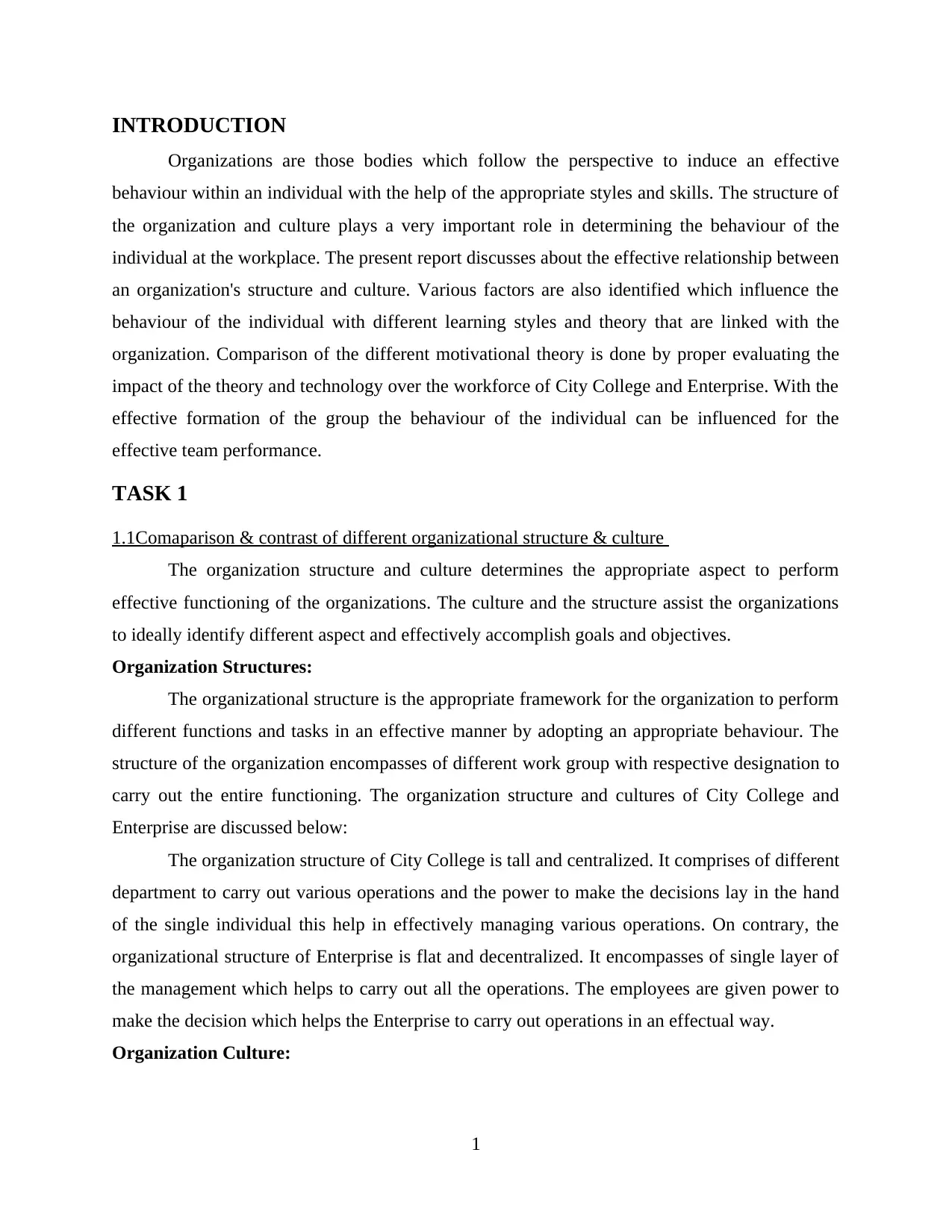
INTRODUCTION
Organizations are those bodies which follow the perspective to induce an effective
behaviour within an individual with the help of the appropriate styles and skills. The structure of
the organization and culture plays a very important role in determining the behaviour of the
individual at the workplace. The present report discusses about the effective relationship between
an organization's structure and culture. Various factors are also identified which influence the
behaviour of the individual with different learning styles and theory that are linked with the
organization. Comparison of the different motivational theory is done by proper evaluating the
impact of the theory and technology over the workforce of City College and Enterprise. With the
effective formation of the group the behaviour of the individual can be influenced for the
effective team performance.
TASK 1
1.1Comaparison & contrast of different organizational structure & culture
The organization structure and culture determines the appropriate aspect to perform
effective functioning of the organizations. The culture and the structure assist the organizations
to ideally identify different aspect and effectively accomplish goals and objectives.
Organization Structures:
The organizational structure is the appropriate framework for the organization to perform
different functions and tasks in an effective manner by adopting an appropriate behaviour. The
structure of the organization encompasses of different work group with respective designation to
carry out the entire functioning. The organization structure and cultures of City College and
Enterprise are discussed below:
The organization structure of City College is tall and centralized. It comprises of different
department to carry out various operations and the power to make the decisions lay in the hand
of the single individual this help in effectively managing various operations. On contrary, the
organizational structure of Enterprise is flat and decentralized. It encompasses of single layer of
the management which helps to carry out all the operations. The employees are given power to
make the decision which helps the Enterprise to carry out operations in an effectual way.
Organization Culture:
1
Organizations are those bodies which follow the perspective to induce an effective
behaviour within an individual with the help of the appropriate styles and skills. The structure of
the organization and culture plays a very important role in determining the behaviour of the
individual at the workplace. The present report discusses about the effective relationship between
an organization's structure and culture. Various factors are also identified which influence the
behaviour of the individual with different learning styles and theory that are linked with the
organization. Comparison of the different motivational theory is done by proper evaluating the
impact of the theory and technology over the workforce of City College and Enterprise. With the
effective formation of the group the behaviour of the individual can be influenced for the
effective team performance.
TASK 1
1.1Comaparison & contrast of different organizational structure & culture
The organization structure and culture determines the appropriate aspect to perform
effective functioning of the organizations. The culture and the structure assist the organizations
to ideally identify different aspect and effectively accomplish goals and objectives.
Organization Structures:
The organizational structure is the appropriate framework for the organization to perform
different functions and tasks in an effective manner by adopting an appropriate behaviour. The
structure of the organization encompasses of different work group with respective designation to
carry out the entire functioning. The organization structure and cultures of City College and
Enterprise are discussed below:
The organization structure of City College is tall and centralized. It comprises of different
department to carry out various operations and the power to make the decisions lay in the hand
of the single individual this help in effectively managing various operations. On contrary, the
organizational structure of Enterprise is flat and decentralized. It encompasses of single layer of
the management which helps to carry out all the operations. The employees are given power to
make the decision which helps the Enterprise to carry out operations in an effectual way.
Organization Culture:
1
⊘ This is a preview!⊘
Do you want full access?
Subscribe today to unlock all pages.

Trusted by 1+ million students worldwide
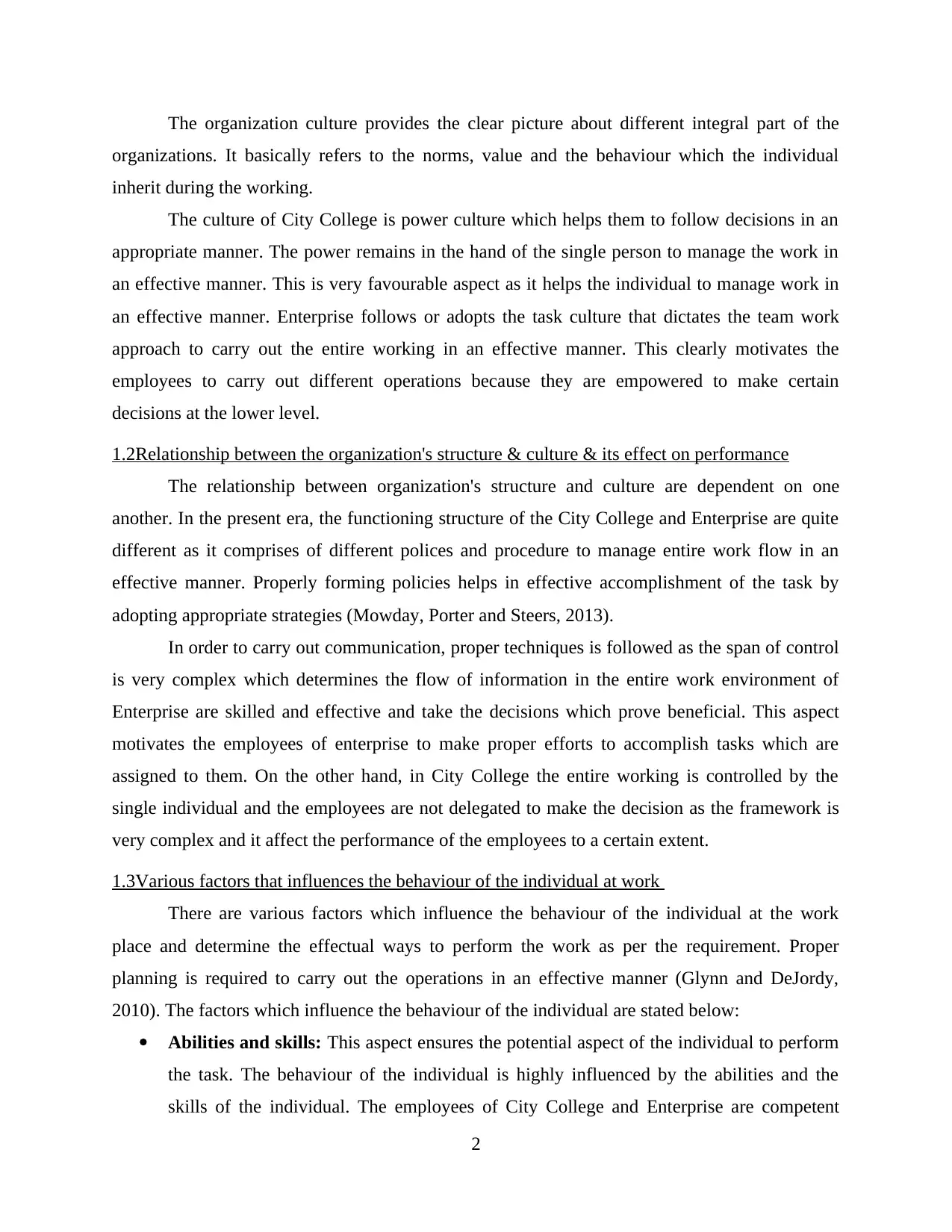
The organization culture provides the clear picture about different integral part of the
organizations. It basically refers to the norms, value and the behaviour which the individual
inherit during the working.
The culture of City College is power culture which helps them to follow decisions in an
appropriate manner. The power remains in the hand of the single person to manage the work in
an effective manner. This is very favourable aspect as it helps the individual to manage work in
an effective manner. Enterprise follows or adopts the task culture that dictates the team work
approach to carry out the entire working in an effective manner. This clearly motivates the
employees to carry out different operations because they are empowered to make certain
decisions at the lower level.
1.2Relationship between the organization's structure & culture & its effect on performance
The relationship between organization's structure and culture are dependent on one
another. In the present era, the functioning structure of the City College and Enterprise are quite
different as it comprises of different polices and procedure to manage entire work flow in an
effective manner. Properly forming policies helps in effective accomplishment of the task by
adopting appropriate strategies (Mowday, Porter and Steers, 2013).
In order to carry out communication, proper techniques is followed as the span of control
is very complex which determines the flow of information in the entire work environment of
Enterprise are skilled and effective and take the decisions which prove beneficial. This aspect
motivates the employees of enterprise to make proper efforts to accomplish tasks which are
assigned to them. On the other hand, in City College the entire working is controlled by the
single individual and the employees are not delegated to make the decision as the framework is
very complex and it affect the performance of the employees to a certain extent.
1.3Various factors that influences the behaviour of the individual at work
There are various factors which influence the behaviour of the individual at the work
place and determine the effectual ways to perform the work as per the requirement. Proper
planning is required to carry out the operations in an effective manner (Glynn and DeJordy,
2010). The factors which influence the behaviour of the individual are stated below:
Abilities and skills: This aspect ensures the potential aspect of the individual to perform
the task. The behaviour of the individual is highly influenced by the abilities and the
skills of the individual. The employees of City College and Enterprise are competent
2
organizations. It basically refers to the norms, value and the behaviour which the individual
inherit during the working.
The culture of City College is power culture which helps them to follow decisions in an
appropriate manner. The power remains in the hand of the single person to manage the work in
an effective manner. This is very favourable aspect as it helps the individual to manage work in
an effective manner. Enterprise follows or adopts the task culture that dictates the team work
approach to carry out the entire working in an effective manner. This clearly motivates the
employees to carry out different operations because they are empowered to make certain
decisions at the lower level.
1.2Relationship between the organization's structure & culture & its effect on performance
The relationship between organization's structure and culture are dependent on one
another. In the present era, the functioning structure of the City College and Enterprise are quite
different as it comprises of different polices and procedure to manage entire work flow in an
effective manner. Properly forming policies helps in effective accomplishment of the task by
adopting appropriate strategies (Mowday, Porter and Steers, 2013).
In order to carry out communication, proper techniques is followed as the span of control
is very complex which determines the flow of information in the entire work environment of
Enterprise are skilled and effective and take the decisions which prove beneficial. This aspect
motivates the employees of enterprise to make proper efforts to accomplish tasks which are
assigned to them. On the other hand, in City College the entire working is controlled by the
single individual and the employees are not delegated to make the decision as the framework is
very complex and it affect the performance of the employees to a certain extent.
1.3Various factors that influences the behaviour of the individual at work
There are various factors which influence the behaviour of the individual at the work
place and determine the effectual ways to perform the work as per the requirement. Proper
planning is required to carry out the operations in an effective manner (Glynn and DeJordy,
2010). The factors which influence the behaviour of the individual are stated below:
Abilities and skills: This aspect ensures the potential aspect of the individual to perform
the task. The behaviour of the individual is highly influenced by the abilities and the
skills of the individual. The employees of City College and Enterprise are competent
2
Paraphrase This Document
Need a fresh take? Get an instant paraphrase of this document with our AI Paraphraser
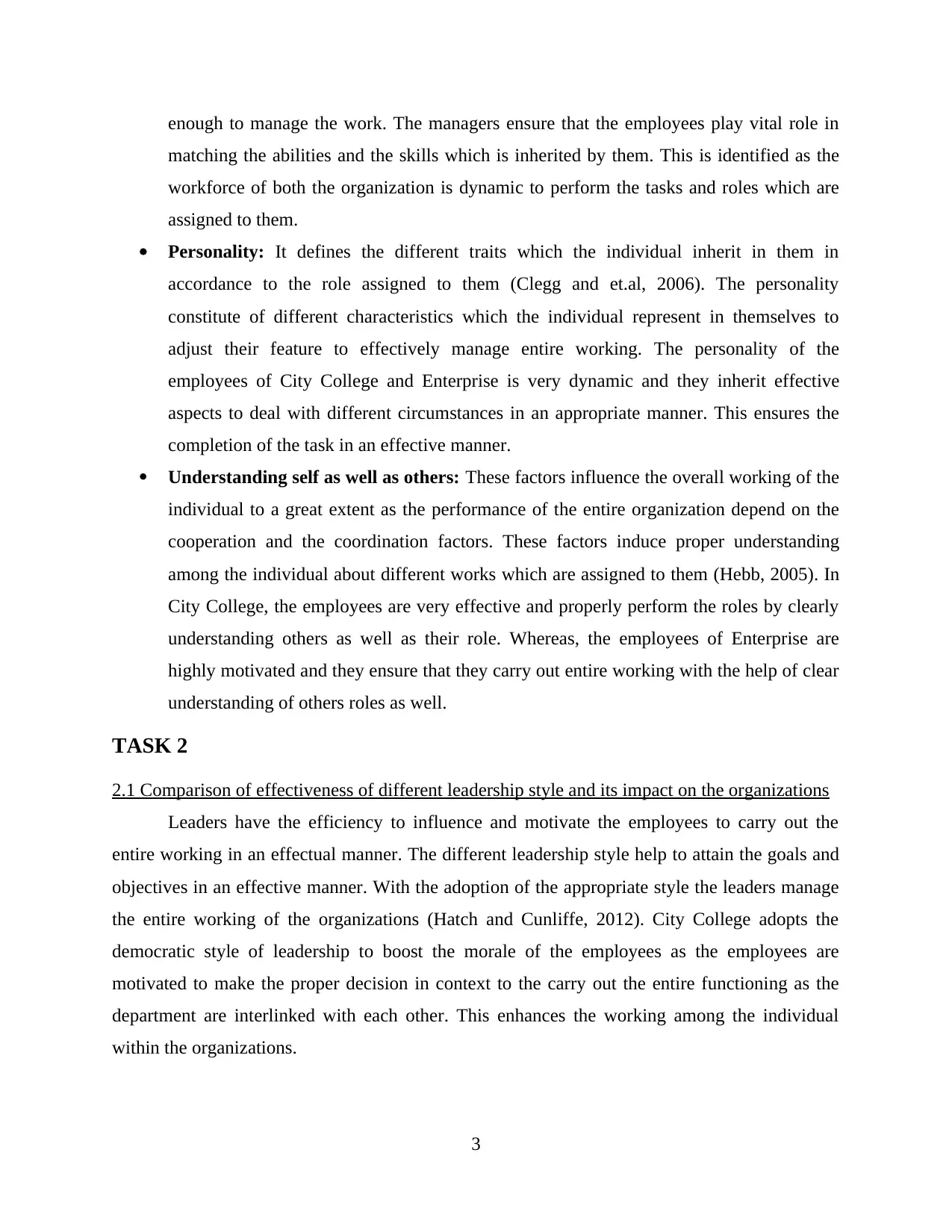
enough to manage the work. The managers ensure that the employees play vital role in
matching the abilities and the skills which is inherited by them. This is identified as the
workforce of both the organization is dynamic to perform the tasks and roles which are
assigned to them.
Personality: It defines the different traits which the individual inherit in them in
accordance to the role assigned to them (Clegg and et.al, 2006). The personality
constitute of different characteristics which the individual represent in themselves to
adjust their feature to effectively manage entire working. The personality of the
employees of City College and Enterprise is very dynamic and they inherit effective
aspects to deal with different circumstances in an appropriate manner. This ensures the
completion of the task in an effective manner.
Understanding self as well as others: These factors influence the overall working of the
individual to a great extent as the performance of the entire organization depend on the
cooperation and the coordination factors. These factors induce proper understanding
among the individual about different works which are assigned to them (Hebb, 2005). In
City College, the employees are very effective and properly perform the roles by clearly
understanding others as well as their role. Whereas, the employees of Enterprise are
highly motivated and they ensure that they carry out entire working with the help of clear
understanding of others roles as well.
TASK 2
2.1 Comparison of effectiveness of different leadership style and its impact on the organizations
Leaders have the efficiency to influence and motivate the employees to carry out the
entire working in an effectual manner. The different leadership style help to attain the goals and
objectives in an effective manner. With the adoption of the appropriate style the leaders manage
the entire working of the organizations (Hatch and Cunliffe, 2012). City College adopts the
democratic style of leadership to boost the morale of the employees as the employees are
motivated to make the proper decision in context to the carry out the entire functioning as the
department are interlinked with each other. This enhances the working among the individual
within the organizations.
3
matching the abilities and the skills which is inherited by them. This is identified as the
workforce of both the organization is dynamic to perform the tasks and roles which are
assigned to them.
Personality: It defines the different traits which the individual inherit in them in
accordance to the role assigned to them (Clegg and et.al, 2006). The personality
constitute of different characteristics which the individual represent in themselves to
adjust their feature to effectively manage entire working. The personality of the
employees of City College and Enterprise is very dynamic and they inherit effective
aspects to deal with different circumstances in an appropriate manner. This ensures the
completion of the task in an effective manner.
Understanding self as well as others: These factors influence the overall working of the
individual to a great extent as the performance of the entire organization depend on the
cooperation and the coordination factors. These factors induce proper understanding
among the individual about different works which are assigned to them (Hebb, 2005). In
City College, the employees are very effective and properly perform the roles by clearly
understanding others as well as their role. Whereas, the employees of Enterprise are
highly motivated and they ensure that they carry out entire working with the help of clear
understanding of others roles as well.
TASK 2
2.1 Comparison of effectiveness of different leadership style and its impact on the organizations
Leaders have the efficiency to influence and motivate the employees to carry out the
entire working in an effectual manner. The different leadership style help to attain the goals and
objectives in an effective manner. With the adoption of the appropriate style the leaders manage
the entire working of the organizations (Hatch and Cunliffe, 2012). City College adopts the
democratic style of leadership to boost the morale of the employees as the employees are
motivated to make the proper decision in context to the carry out the entire functioning as the
department are interlinked with each other. This enhances the working among the individual
within the organizations.
3
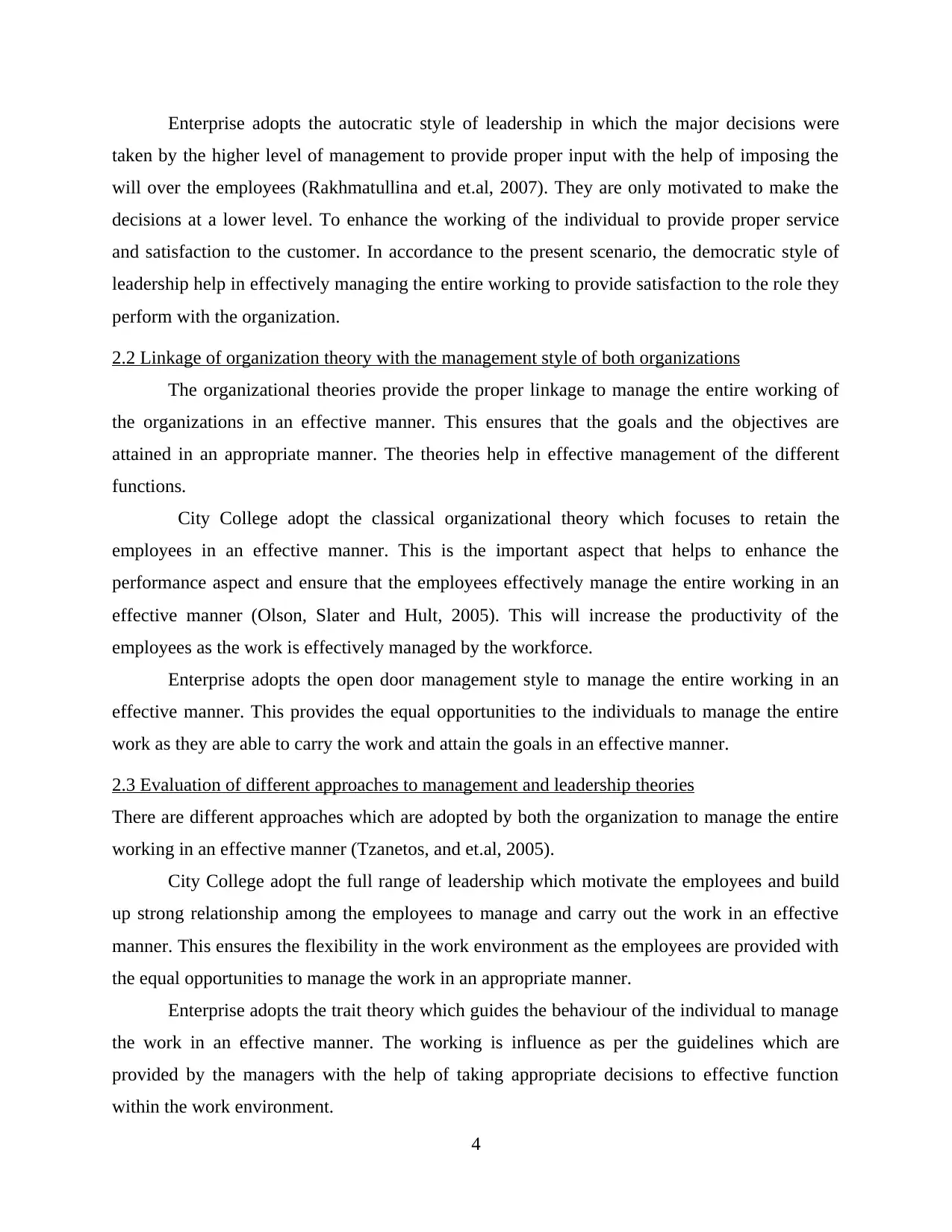
Enterprise adopts the autocratic style of leadership in which the major decisions were
taken by the higher level of management to provide proper input with the help of imposing the
will over the employees (Rakhmatullina and et.al, 2007). They are only motivated to make the
decisions at a lower level. To enhance the working of the individual to provide proper service
and satisfaction to the customer. In accordance to the present scenario, the democratic style of
leadership help in effectively managing the entire working to provide satisfaction to the role they
perform with the organization.
2.2 Linkage of organization theory with the management style of both organizations
The organizational theories provide the proper linkage to manage the entire working of
the organizations in an effective manner. This ensures that the goals and the objectives are
attained in an appropriate manner. The theories help in effective management of the different
functions.
City College adopt the classical organizational theory which focuses to retain the
employees in an effective manner. This is the important aspect that helps to enhance the
performance aspect and ensure that the employees effectively manage the entire working in an
effective manner (Olson, Slater and Hult, 2005). This will increase the productivity of the
employees as the work is effectively managed by the workforce.
Enterprise adopts the open door management style to manage the entire working in an
effective manner. This provides the equal opportunities to the individuals to manage the entire
work as they are able to carry the work and attain the goals in an effective manner.
2.3 Evaluation of different approaches to management and leadership theories
There are different approaches which are adopted by both the organization to manage the entire
working in an effective manner (Tzanetos, and et.al, 2005).
City College adopt the full range of leadership which motivate the employees and build
up strong relationship among the employees to manage and carry out the work in an effective
manner. This ensures the flexibility in the work environment as the employees are provided with
the equal opportunities to manage the work in an appropriate manner.
Enterprise adopts the trait theory which guides the behaviour of the individual to manage
the work in an effective manner. The working is influence as per the guidelines which are
provided by the managers with the help of taking appropriate decisions to effective function
within the work environment.
4
taken by the higher level of management to provide proper input with the help of imposing the
will over the employees (Rakhmatullina and et.al, 2007). They are only motivated to make the
decisions at a lower level. To enhance the working of the individual to provide proper service
and satisfaction to the customer. In accordance to the present scenario, the democratic style of
leadership help in effectively managing the entire working to provide satisfaction to the role they
perform with the organization.
2.2 Linkage of organization theory with the management style of both organizations
The organizational theories provide the proper linkage to manage the entire working of
the organizations in an effective manner. This ensures that the goals and the objectives are
attained in an appropriate manner. The theories help in effective management of the different
functions.
City College adopt the classical organizational theory which focuses to retain the
employees in an effective manner. This is the important aspect that helps to enhance the
performance aspect and ensure that the employees effectively manage the entire working in an
effective manner (Olson, Slater and Hult, 2005). This will increase the productivity of the
employees as the work is effectively managed by the workforce.
Enterprise adopts the open door management style to manage the entire working in an
effective manner. This provides the equal opportunities to the individuals to manage the entire
work as they are able to carry the work and attain the goals in an effective manner.
2.3 Evaluation of different approaches to management and leadership theories
There are different approaches which are adopted by both the organization to manage the entire
working in an effective manner (Tzanetos, and et.al, 2005).
City College adopt the full range of leadership which motivate the employees and build
up strong relationship among the employees to manage and carry out the work in an effective
manner. This ensures the flexibility in the work environment as the employees are provided with
the equal opportunities to manage the work in an appropriate manner.
Enterprise adopts the trait theory which guides the behaviour of the individual to manage
the work in an effective manner. The working is influence as per the guidelines which are
provided by the managers with the help of taking appropriate decisions to effective function
within the work environment.
4
⊘ This is a preview!⊘
Do you want full access?
Subscribe today to unlock all pages.

Trusted by 1+ million students worldwide
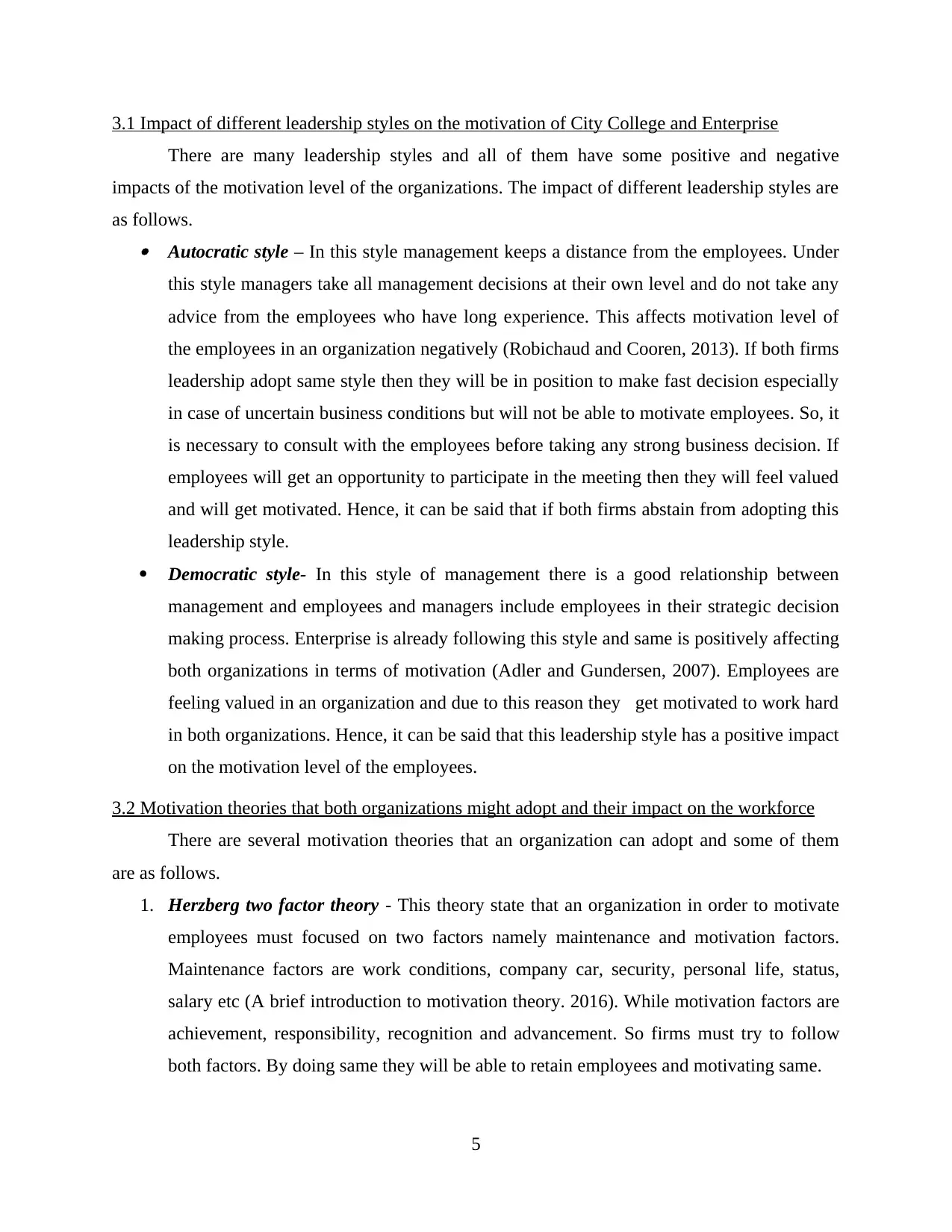
3.1 Impact of different leadership styles on the motivation of City College and Enterprise
There are many leadership styles and all of them have some positive and negative
impacts of the motivation level of the organizations. The impact of different leadership styles are
as follows. Autocratic style – In this style management keeps a distance from the employees. Under
this style managers take all management decisions at their own level and do not take any
advice from the employees who have long experience. This affects motivation level of
the employees in an organization negatively (Robichaud and Cooren, 2013). If both firms
leadership adopt same style then they will be in position to make fast decision especially
in case of uncertain business conditions but will not be able to motivate employees. So, it
is necessary to consult with the employees before taking any strong business decision. If
employees will get an opportunity to participate in the meeting then they will feel valued
and will get motivated. Hence, it can be said that if both firms abstain from adopting this
leadership style.
Democratic style- In this style of management there is a good relationship between
management and employees and managers include employees in their strategic decision
making process. Enterprise is already following this style and same is positively affecting
both organizations in terms of motivation (Adler and Gundersen, 2007). Employees are
feeling valued in an organization and due to this reason they get motivated to work hard
in both organizations. Hence, it can be said that this leadership style has a positive impact
on the motivation level of the employees.
3.2 Motivation theories that both organizations might adopt and their impact on the workforce
There are several motivation theories that an organization can adopt and some of them
are as follows.
1. Herzberg two factor theory - This theory state that an organization in order to motivate
employees must focused on two factors namely maintenance and motivation factors.
Maintenance factors are work conditions, company car, security, personal life, status,
salary etc (A brief introduction to motivation theory. 2016). While motivation factors are
achievement, responsibility, recognition and advancement. So firms must try to follow
both factors. By doing same they will be able to retain employees and motivating same.
5
There are many leadership styles and all of them have some positive and negative
impacts of the motivation level of the organizations. The impact of different leadership styles are
as follows. Autocratic style – In this style management keeps a distance from the employees. Under
this style managers take all management decisions at their own level and do not take any
advice from the employees who have long experience. This affects motivation level of
the employees in an organization negatively (Robichaud and Cooren, 2013). If both firms
leadership adopt same style then they will be in position to make fast decision especially
in case of uncertain business conditions but will not be able to motivate employees. So, it
is necessary to consult with the employees before taking any strong business decision. If
employees will get an opportunity to participate in the meeting then they will feel valued
and will get motivated. Hence, it can be said that if both firms abstain from adopting this
leadership style.
Democratic style- In this style of management there is a good relationship between
management and employees and managers include employees in their strategic decision
making process. Enterprise is already following this style and same is positively affecting
both organizations in terms of motivation (Adler and Gundersen, 2007). Employees are
feeling valued in an organization and due to this reason they get motivated to work hard
in both organizations. Hence, it can be said that this leadership style has a positive impact
on the motivation level of the employees.
3.2 Motivation theories that both organizations might adopt and their impact on the workforce
There are several motivation theories that an organization can adopt and some of them
are as follows.
1. Herzberg two factor theory - This theory state that an organization in order to motivate
employees must focused on two factors namely maintenance and motivation factors.
Maintenance factors are work conditions, company car, security, personal life, status,
salary etc (A brief introduction to motivation theory. 2016). While motivation factors are
achievement, responsibility, recognition and advancement. So firms must try to follow
both factors. By doing same they will be able to retain employees and motivating same.
5
Paraphrase This Document
Need a fresh take? Get an instant paraphrase of this document with our AI Paraphraser
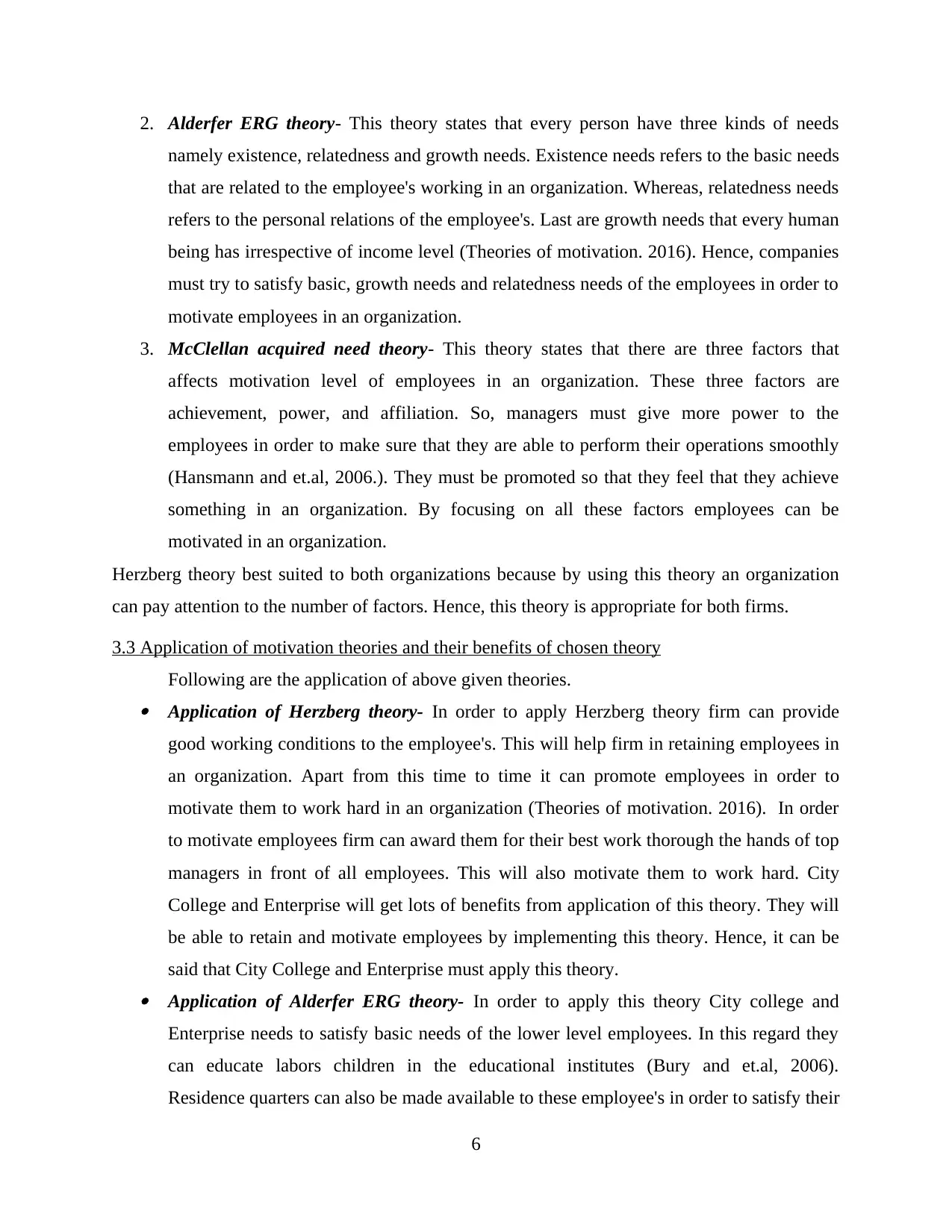
2. Alderfer ERG theory- This theory states that every person have three kinds of needs
namely existence, relatedness and growth needs. Existence needs refers to the basic needs
that are related to the employee's working in an organization. Whereas, relatedness needs
refers to the personal relations of the employee's. Last are growth needs that every human
being has irrespective of income level (Theories of motivation. 2016). Hence, companies
must try to satisfy basic, growth needs and relatedness needs of the employees in order to
motivate employees in an organization.
3. McClellan acquired need theory- This theory states that there are three factors that
affects motivation level of employees in an organization. These three factors are
achievement, power, and affiliation. So, managers must give more power to the
employees in order to make sure that they are able to perform their operations smoothly
(Hansmann and et.al, 2006.). They must be promoted so that they feel that they achieve
something in an organization. By focusing on all these factors employees can be
motivated in an organization.
Herzberg theory best suited to both organizations because by using this theory an organization
can pay attention to the number of factors. Hence, this theory is appropriate for both firms.
3.3 Application of motivation theories and their benefits of chosen theory
Following are the application of above given theories. Application of Herzberg theory- In order to apply Herzberg theory firm can provide
good working conditions to the employee's. This will help firm in retaining employees in
an organization. Apart from this time to time it can promote employees in order to
motivate them to work hard in an organization (Theories of motivation. 2016). In order
to motivate employees firm can award them for their best work thorough the hands of top
managers in front of all employees. This will also motivate them to work hard. City
College and Enterprise will get lots of benefits from application of this theory. They will
be able to retain and motivate employees by implementing this theory. Hence, it can be
said that City College and Enterprise must apply this theory. Application of Alderfer ERG theory- In order to apply this theory City college and
Enterprise needs to satisfy basic needs of the lower level employees. In this regard they
can educate labors children in the educational institutes (Bury and et.al, 2006).
Residence quarters can also be made available to these employee's in order to satisfy their
6
namely existence, relatedness and growth needs. Existence needs refers to the basic needs
that are related to the employee's working in an organization. Whereas, relatedness needs
refers to the personal relations of the employee's. Last are growth needs that every human
being has irrespective of income level (Theories of motivation. 2016). Hence, companies
must try to satisfy basic, growth needs and relatedness needs of the employees in order to
motivate employees in an organization.
3. McClellan acquired need theory- This theory states that there are three factors that
affects motivation level of employees in an organization. These three factors are
achievement, power, and affiliation. So, managers must give more power to the
employees in order to make sure that they are able to perform their operations smoothly
(Hansmann and et.al, 2006.). They must be promoted so that they feel that they achieve
something in an organization. By focusing on all these factors employees can be
motivated in an organization.
Herzberg theory best suited to both organizations because by using this theory an organization
can pay attention to the number of factors. Hence, this theory is appropriate for both firms.
3.3 Application of motivation theories and their benefits of chosen theory
Following are the application of above given theories. Application of Herzberg theory- In order to apply Herzberg theory firm can provide
good working conditions to the employee's. This will help firm in retaining employees in
an organization. Apart from this time to time it can promote employees in order to
motivate them to work hard in an organization (Theories of motivation. 2016). In order
to motivate employees firm can award them for their best work thorough the hands of top
managers in front of all employees. This will also motivate them to work hard. City
College and Enterprise will get lots of benefits from application of this theory. They will
be able to retain and motivate employees by implementing this theory. Hence, it can be
said that City College and Enterprise must apply this theory. Application of Alderfer ERG theory- In order to apply this theory City college and
Enterprise needs to satisfy basic needs of the lower level employees. In this regard they
can educate labors children in the educational institutes (Bury and et.al, 2006).
Residence quarters can also be made available to these employee's in order to satisfy their
6
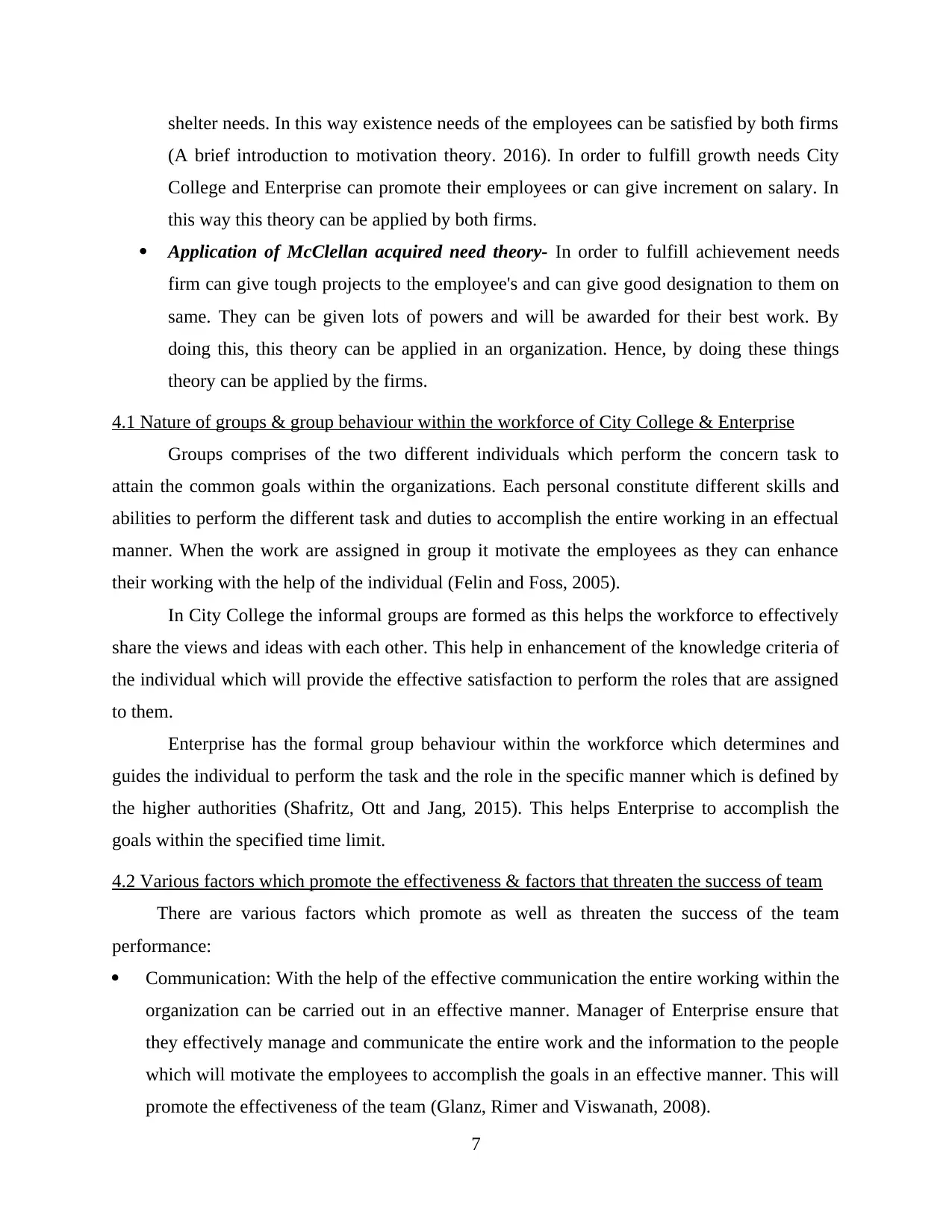
shelter needs. In this way existence needs of the employees can be satisfied by both firms
(A brief introduction to motivation theory. 2016). In order to fulfill growth needs City
College and Enterprise can promote their employees or can give increment on salary. In
this way this theory can be applied by both firms.
Application of McClellan acquired need theory- In order to fulfill achievement needs
firm can give tough projects to the employee's and can give good designation to them on
same. They can be given lots of powers and will be awarded for their best work. By
doing this, this theory can be applied in an organization. Hence, by doing these things
theory can be applied by the firms.
4.1 Nature of groups & group behaviour within the workforce of City College & Enterprise
Groups comprises of the two different individuals which perform the concern task to
attain the common goals within the organizations. Each personal constitute different skills and
abilities to perform the different task and duties to accomplish the entire working in an effectual
manner. When the work are assigned in group it motivate the employees as they can enhance
their working with the help of the individual (Felin and Foss, 2005).
In City College the informal groups are formed as this helps the workforce to effectively
share the views and ideas with each other. This help in enhancement of the knowledge criteria of
the individual which will provide the effective satisfaction to perform the roles that are assigned
to them.
Enterprise has the formal group behaviour within the workforce which determines and
guides the individual to perform the task and the role in the specific manner which is defined by
the higher authorities (Shafritz, Ott and Jang, 2015). This helps Enterprise to accomplish the
goals within the specified time limit.
4.2 Various factors which promote the effectiveness & factors that threaten the success of team
There are various factors which promote as well as threaten the success of the team
performance:
Communication: With the help of the effective communication the entire working within the
organization can be carried out in an effective manner. Manager of Enterprise ensure that
they effectively manage and communicate the entire work and the information to the people
which will motivate the employees to accomplish the goals in an effective manner. This will
promote the effectiveness of the team (Glanz, Rimer and Viswanath, 2008).
7
(A brief introduction to motivation theory. 2016). In order to fulfill growth needs City
College and Enterprise can promote their employees or can give increment on salary. In
this way this theory can be applied by both firms.
Application of McClellan acquired need theory- In order to fulfill achievement needs
firm can give tough projects to the employee's and can give good designation to them on
same. They can be given lots of powers and will be awarded for their best work. By
doing this, this theory can be applied in an organization. Hence, by doing these things
theory can be applied by the firms.
4.1 Nature of groups & group behaviour within the workforce of City College & Enterprise
Groups comprises of the two different individuals which perform the concern task to
attain the common goals within the organizations. Each personal constitute different skills and
abilities to perform the different task and duties to accomplish the entire working in an effectual
manner. When the work are assigned in group it motivate the employees as they can enhance
their working with the help of the individual (Felin and Foss, 2005).
In City College the informal groups are formed as this helps the workforce to effectively
share the views and ideas with each other. This help in enhancement of the knowledge criteria of
the individual which will provide the effective satisfaction to perform the roles that are assigned
to them.
Enterprise has the formal group behaviour within the workforce which determines and
guides the individual to perform the task and the role in the specific manner which is defined by
the higher authorities (Shafritz, Ott and Jang, 2015). This helps Enterprise to accomplish the
goals within the specified time limit.
4.2 Various factors which promote the effectiveness & factors that threaten the success of team
There are various factors which promote as well as threaten the success of the team
performance:
Communication: With the help of the effective communication the entire working within the
organization can be carried out in an effective manner. Manager of Enterprise ensure that
they effectively manage and communicate the entire work and the information to the people
which will motivate the employees to accomplish the goals in an effective manner. This will
promote the effectiveness of the team (Glanz, Rimer and Viswanath, 2008).
7
⊘ This is a preview!⊘
Do you want full access?
Subscribe today to unlock all pages.

Trusted by 1+ million students worldwide
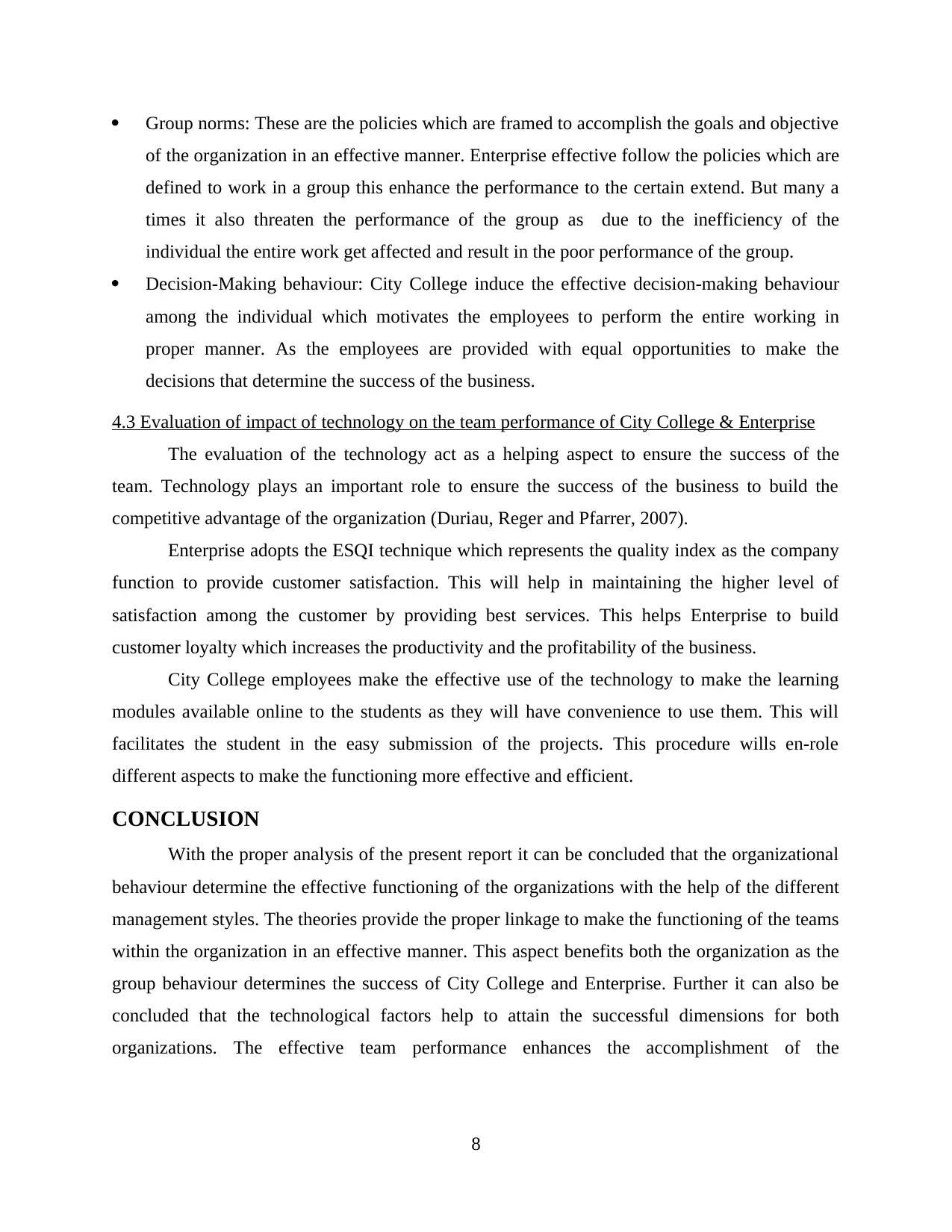
Group norms: These are the policies which are framed to accomplish the goals and objective
of the organization in an effective manner. Enterprise effective follow the policies which are
defined to work in a group this enhance the performance to the certain extend. But many a
times it also threaten the performance of the group as due to the inefficiency of the
individual the entire work get affected and result in the poor performance of the group.
Decision-Making behaviour: City College induce the effective decision-making behaviour
among the individual which motivates the employees to perform the entire working in
proper manner. As the employees are provided with equal opportunities to make the
decisions that determine the success of the business.
4.3 Evaluation of impact of technology on the team performance of City College & Enterprise
The evaluation of the technology act as a helping aspect to ensure the success of the
team. Technology plays an important role to ensure the success of the business to build the
competitive advantage of the organization (Duriau, Reger and Pfarrer, 2007).
Enterprise adopts the ESQI technique which represents the quality index as the company
function to provide customer satisfaction. This will help in maintaining the higher level of
satisfaction among the customer by providing best services. This helps Enterprise to build
customer loyalty which increases the productivity and the profitability of the business.
City College employees make the effective use of the technology to make the learning
modules available online to the students as they will have convenience to use them. This will
facilitates the student in the easy submission of the projects. This procedure wills en-role
different aspects to make the functioning more effective and efficient.
CONCLUSION
With the proper analysis of the present report it can be concluded that the organizational
behaviour determine the effective functioning of the organizations with the help of the different
management styles. The theories provide the proper linkage to make the functioning of the teams
within the organization in an effective manner. This aspect benefits both the organization as the
group behaviour determines the success of City College and Enterprise. Further it can also be
concluded that the technological factors help to attain the successful dimensions for both
organizations. The effective team performance enhances the accomplishment of the
8
of the organization in an effective manner. Enterprise effective follow the policies which are
defined to work in a group this enhance the performance to the certain extend. But many a
times it also threaten the performance of the group as due to the inefficiency of the
individual the entire work get affected and result in the poor performance of the group.
Decision-Making behaviour: City College induce the effective decision-making behaviour
among the individual which motivates the employees to perform the entire working in
proper manner. As the employees are provided with equal opportunities to make the
decisions that determine the success of the business.
4.3 Evaluation of impact of technology on the team performance of City College & Enterprise
The evaluation of the technology act as a helping aspect to ensure the success of the
team. Technology plays an important role to ensure the success of the business to build the
competitive advantage of the organization (Duriau, Reger and Pfarrer, 2007).
Enterprise adopts the ESQI technique which represents the quality index as the company
function to provide customer satisfaction. This will help in maintaining the higher level of
satisfaction among the customer by providing best services. This helps Enterprise to build
customer loyalty which increases the productivity and the profitability of the business.
City College employees make the effective use of the technology to make the learning
modules available online to the students as they will have convenience to use them. This will
facilitates the student in the easy submission of the projects. This procedure wills en-role
different aspects to make the functioning more effective and efficient.
CONCLUSION
With the proper analysis of the present report it can be concluded that the organizational
behaviour determine the effective functioning of the organizations with the help of the different
management styles. The theories provide the proper linkage to make the functioning of the teams
within the organization in an effective manner. This aspect benefits both the organization as the
group behaviour determines the success of City College and Enterprise. Further it can also be
concluded that the technological factors help to attain the successful dimensions for both
organizations. The effective team performance enhances the accomplishment of the
8
Paraphrase This Document
Need a fresh take? Get an instant paraphrase of this document with our AI Paraphraser
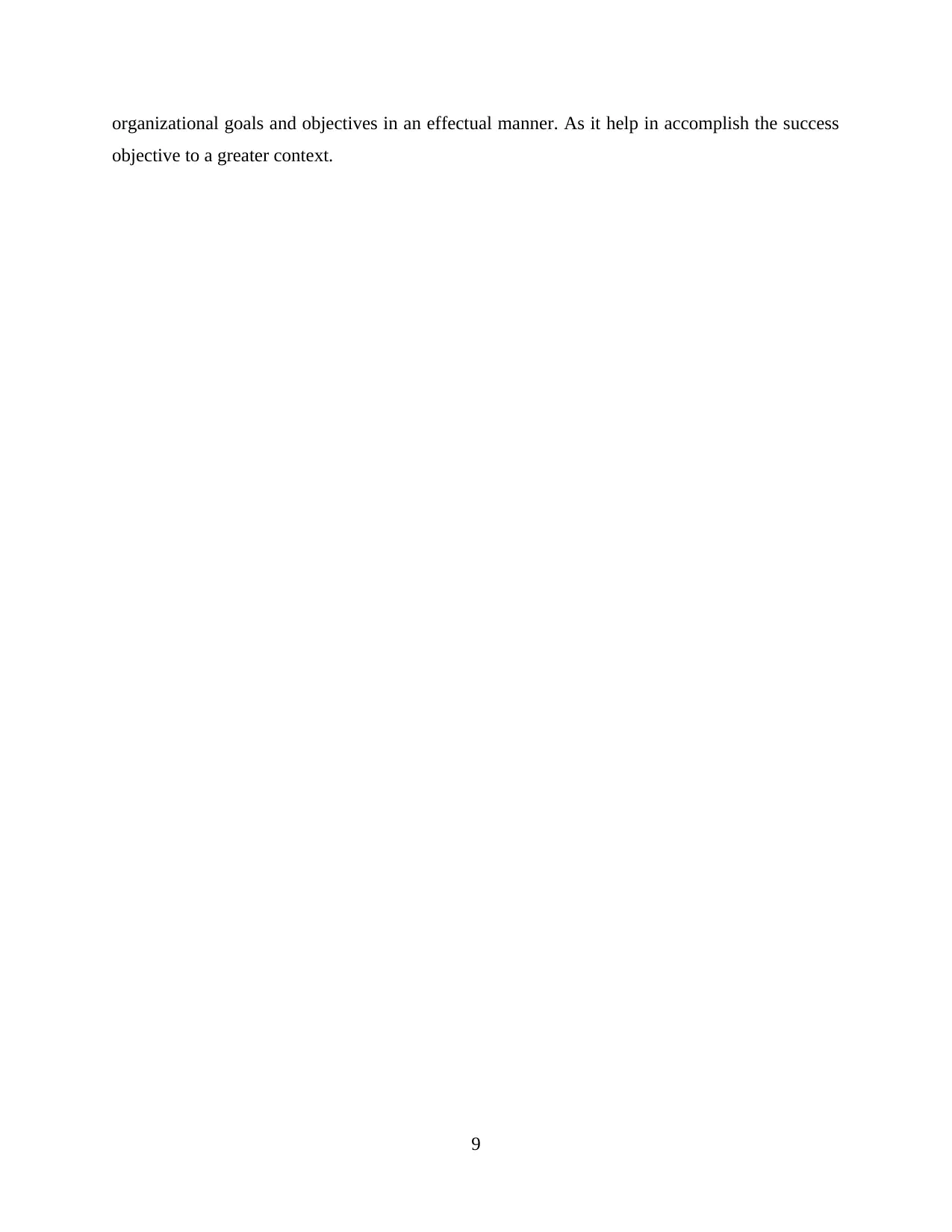
organizational goals and objectives in an effectual manner. As it help in accomplish the success
objective to a greater context.
9
objective to a greater context.
9
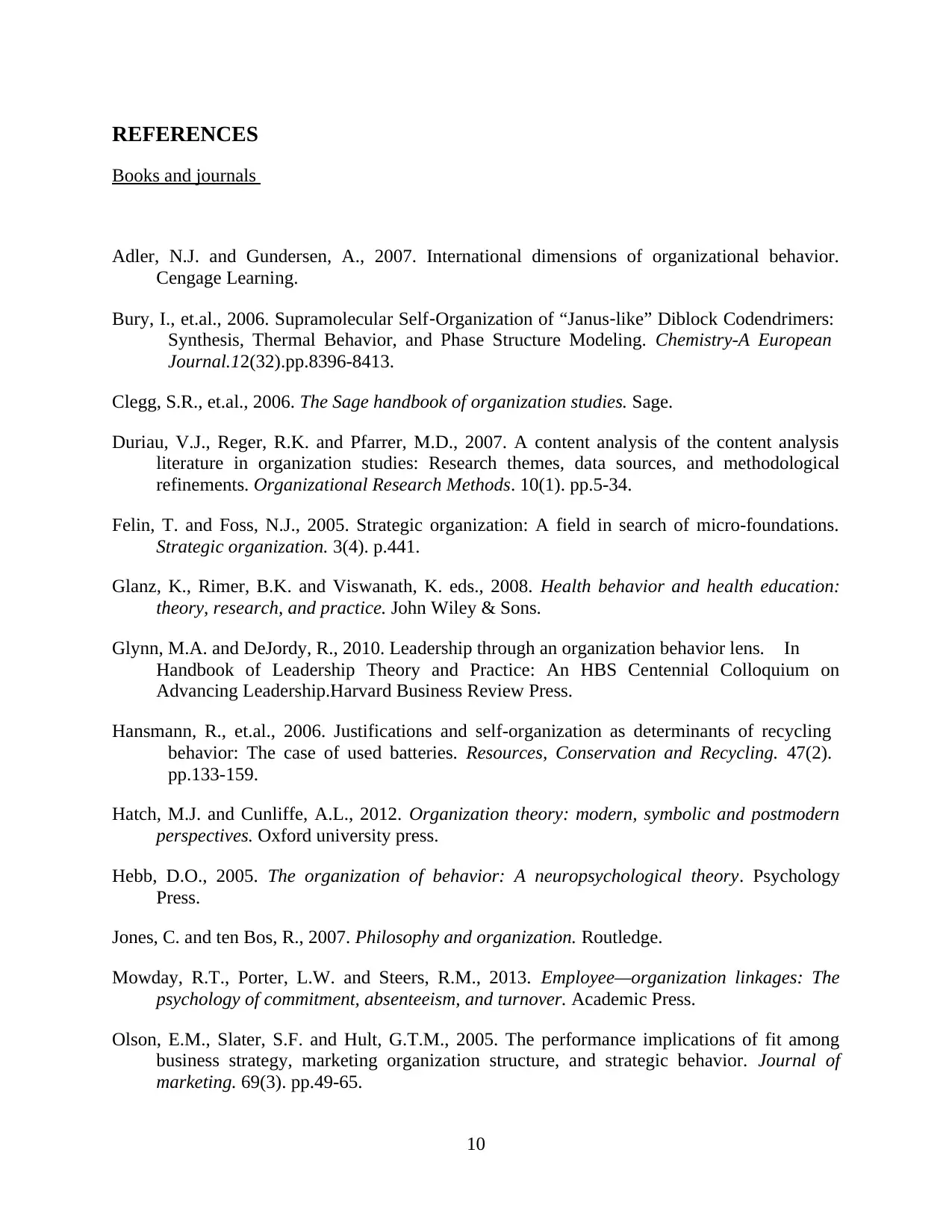
REFERENCES
Books and journals
Adler, N.J. and Gundersen, A., 2007. International dimensions of organizational behavior.
Cengage Learning.
Bury, I., et.al., 2006. Supramolecular Self‐Organization of “Janus‐like” Diblock Codendrimers:
Synthesis, Thermal Behavior, and Phase Structure Modeling. Chemistry-A European
Journal.12(32).pp.8396-8413.
Clegg, S.R., et.al., 2006. The Sage handbook of organization studies. Sage.
Duriau, V.J., Reger, R.K. and Pfarrer, M.D., 2007. A content analysis of the content analysis
literature in organization studies: Research themes, data sources, and methodological
refinements. Organizational Research Methods. 10(1). pp.5-34.
Felin, T. and Foss, N.J., 2005. Strategic organization: A field in search of micro-foundations.
Strategic organization. 3(4). p.441.
Glanz, K., Rimer, B.K. and Viswanath, K. eds., 2008. Health behavior and health education:
theory, research, and practice. John Wiley & Sons.
Glynn, M.A. and DeJordy, R., 2010. Leadership through an organization behavior lens. In
Handbook of Leadership Theory and Practice: An HBS Centennial Colloquium on
Advancing Leadership.Harvard Business Review Press.
Hansmann, R., et.al., 2006. Justifications and self-organization as determinants of recycling
behavior: The case of used batteries. Resources, Conservation and Recycling. 47(2).
pp.133-159.
Hatch, M.J. and Cunliffe, A.L., 2012. Organization theory: modern, symbolic and postmodern
perspectives. Oxford university press.
Hebb, D.O., 2005. The organization of behavior: A neuropsychological theory. Psychology
Press.
Jones, C. and ten Bos, R., 2007. Philosophy and organization. Routledge.
Mowday, R.T., Porter, L.W. and Steers, R.M., 2013. Employee—organization linkages: The
psychology of commitment, absenteeism, and turnover. Academic Press.
Olson, E.M., Slater, S.F. and Hult, G.T.M., 2005. The performance implications of fit among
business strategy, marketing organization structure, and strategic behavior. Journal of
marketing. 69(3). pp.49-65.
10
Books and journals
Adler, N.J. and Gundersen, A., 2007. International dimensions of organizational behavior.
Cengage Learning.
Bury, I., et.al., 2006. Supramolecular Self‐Organization of “Janus‐like” Diblock Codendrimers:
Synthesis, Thermal Behavior, and Phase Structure Modeling. Chemistry-A European
Journal.12(32).pp.8396-8413.
Clegg, S.R., et.al., 2006. The Sage handbook of organization studies. Sage.
Duriau, V.J., Reger, R.K. and Pfarrer, M.D., 2007. A content analysis of the content analysis
literature in organization studies: Research themes, data sources, and methodological
refinements. Organizational Research Methods. 10(1). pp.5-34.
Felin, T. and Foss, N.J., 2005. Strategic organization: A field in search of micro-foundations.
Strategic organization. 3(4). p.441.
Glanz, K., Rimer, B.K. and Viswanath, K. eds., 2008. Health behavior and health education:
theory, research, and practice. John Wiley & Sons.
Glynn, M.A. and DeJordy, R., 2010. Leadership through an organization behavior lens. In
Handbook of Leadership Theory and Practice: An HBS Centennial Colloquium on
Advancing Leadership.Harvard Business Review Press.
Hansmann, R., et.al., 2006. Justifications and self-organization as determinants of recycling
behavior: The case of used batteries. Resources, Conservation and Recycling. 47(2).
pp.133-159.
Hatch, M.J. and Cunliffe, A.L., 2012. Organization theory: modern, symbolic and postmodern
perspectives. Oxford university press.
Hebb, D.O., 2005. The organization of behavior: A neuropsychological theory. Psychology
Press.
Jones, C. and ten Bos, R., 2007. Philosophy and organization. Routledge.
Mowday, R.T., Porter, L.W. and Steers, R.M., 2013. Employee—organization linkages: The
psychology of commitment, absenteeism, and turnover. Academic Press.
Olson, E.M., Slater, S.F. and Hult, G.T.M., 2005. The performance implications of fit among
business strategy, marketing organization structure, and strategic behavior. Journal of
marketing. 69(3). pp.49-65.
10
⊘ This is a preview!⊘
Do you want full access?
Subscribe today to unlock all pages.

Trusted by 1+ million students worldwide
1 out of 13
Related Documents
Your All-in-One AI-Powered Toolkit for Academic Success.
+13062052269
info@desklib.com
Available 24*7 on WhatsApp / Email
![[object Object]](/_next/static/media/star-bottom.7253800d.svg)
Unlock your academic potential
Copyright © 2020–2025 A2Z Services. All Rights Reserved. Developed and managed by ZUCOL.





